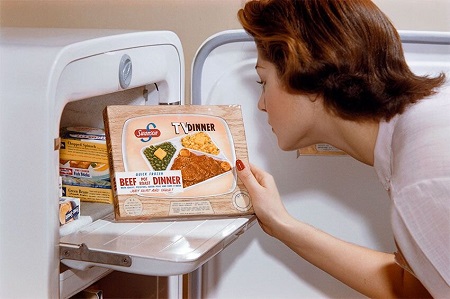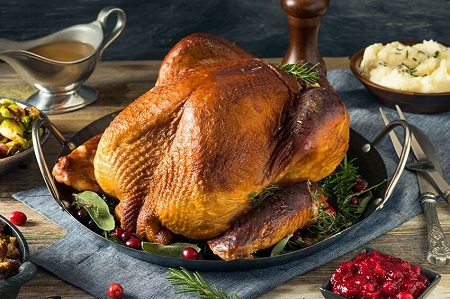The newest registered user is mark5
Our users have posted a total of 48862 messages in 7215 subjects

WORLD CLOCK
THE HISTORY OF TV DINNERS
Valley of the Sun Casual Club :: ENTERTAINMENT , SPORTS & NEWS & SOCIAL MEDIA :: FUNNIEST , BANNED COMERCIALS
 THE HISTORY OF TV DINNERS
THE HISTORY OF TV DINNERS

General
The Delicious History of the TV Dinner
09 | 01 | 2021
When TV dinners debuted in 1954, they had a bit of an identity crisis. It seemed the public either viewed the meals as modern miracles that perfectly complemented the new-fangled novelty of affordable home television sets or the harbinger of society’s downfall that put families on trays in the living room instead of around the family dinner table with a home-cooked meal.
While the jury may still be out on that one, convenience meals (not often called TV dinners these days) continue to be popular, supplying quick and easy lunches for the working masses or meals made in minutes for families between evening activities. Here’s a look back at how the trend started nearly 70 years ago.
Precursors to the TV Dinner

Frozen food did exist before the TV dinner — but it wasn’t pleasant. The freezing process made most food flavorless, and the textures were lacking, at best. Consumers were unimpressed, and the sales numbers showed it.
A couple of food inventions got close to the idea of what would eventually become the TV dinner but didn’t quite hit the mark. First, in 1945, Maxson Food Systems developed meals called “Strato-Plates” meant to serve diners in aircrafts, both military and civilian. The meals consisted of three components — meat, vegetables, and potatoes — served in individual compartments in a tray. But the product fizzled when the company’s founder died, and Maxson Food Systems never quite landed.
In 1947, inventor Jack Fisher got even closer with his “Fridgi-Dinners” product — food frozen in aluminum trays to be reheated later. But his target audience wasn’t the home cook, as TV dinners would later be. Fridgi-Dinners were sold primarily to bars so they could serve hot meals to patrons without the burden of hiring full kitchen staff.
Swanson Enters the Picture

The TV dinner we traditionally think of began to take shape around six years after the Fridgi-Dinner. The story touted by Swanson is that in 1953, salesman Gerry Thomas was faced with the conundrum of how to repurpose roughly 260 tons of turkey leftover from Thanksgiving. The turkey was safe as long as it remained on the refrigerated train cars that housed them, so until Thomas came up with a plan, the turkeys were shipped back and forth between the East Coast and Swanson’s headquarters in Omaha, Nebraska.
It’s unclear how many times the turkeys took the scenic route until a lightbulb went off for Thomas: He would take the leftover turkeys and stick them in an aluminum tray with holiday sides such as stuffing and sweet potatoes. After Swanson’s bacteriologist Betty Cronin conducted research and studies on how to make the process from frozen to reheated food-safe, the classic combo began to sell as an easy-to-reheat meal to consumers. Each meal cost 98 cents and promised to have dinner on the table in 25 minutes.
The tale has been disputed over the years — not that Swanson was responsible, but who within the company first had the idea. Another version credits Swanson brothers Gilbert and Clarke as the originators. Whatever the case may be, it was a turning point for households everywhere. By 1954, Swanson had sold more than 10 million TV dinners, with Banquet Foods and Morton Frozen Foods hot on their trail.
Marketing the “TV Dinner”

We also have Swanson salesman Gerry Thomas to thank for the surprisingly prescient term “TV dinner,” although that claim, too, has been disputed. During the 1950s, women were entering the post-war workforce and weren’t able to spend hours preparing a hot meal. With women in the workplace, Swanson knew they had to make the meals appealing to men as well as women. In 1955, they launched a commercial targeted specifically at the busy working man:
“You take me. I can be early, I can be late, I can bring pals to dinner anytime I please and – get this – my wife never panics! She just takes Swanson TV turkey dinners from the freezing compartment of our refrigerator when I am a little off schedule.”
It worked, and the term “TV dinner” quickly caught on as household televisions became more prevalent. By 1955, shortly after Swanson’s first foray into convenience food, nearly 65% of households had television sets.
More Variations Hit Shelves
Of course, it didn’t take long for companies to branch out from turkey, Salisbury steak, and pot roast. A few of the more memorable attempts include:
- Swanson’s International line: The most questionable of which was a German-style meal that included beef with sauerbraten gravy, spaetzle, Bavarian red cabbage, and a tasty prune and apricot compote for dessert. Other entries under the Swanson International banner included Mexican (enchiladas and tamales), English (fish and chips), and Polynesian (sweet and sour chicken and an orange tea cake for dessert).
- Libbyland Dinners: This brand was the first TV dinner made with kids in mind. Each meal was adventure-themed, and featured illustrated boxes with games on the back and loosely related foods. Some of the “adventures” included sundown supper (hamburger), pirate picnic (hot dog), sea diver’s dinner (fish sticks), and safari supper (fried chicken).
- Le Menu: Another Swanson line aimed at people who presumably had more discerning tastes. One 1983 commercial showed a butler selecting a bottle of wine to go with a boxed meal of beef tips and veal parmigiana.
Since its inception more than half a century ago, the TV dinner has continued to evolve with the times. The advent of the microwave in the mid-1980s sliced the time to heat a frozen meal to just minutes, and in recent years, major restaurant chains like PF Chang’s, TGI Fridays, and White Castle have created frozen versions of their most-loved dishes for supermarket shelves.
 Similar topics
Similar topics» HISTORY FACTS * History's most famous pets *
» HISTORY FACTS * The most famous typos in history *
» HISTORY FACTS *How long was history's shortest war? *
» HISTORY FACTS * The loudest sound in history *
Valley of the Sun Casual Club :: ENTERTAINMENT , SPORTS & NEWS & SOCIAL MEDIA :: FUNNIEST , BANNED COMERCIALS

 Events
Events



















































































» *POPULAR CONTENTS* Valley of the SUN Official Newsletter
» Disneyland vacation
» WGT POETRY , QUOTES , MOMENTS , & MORE
» Word Genius Word of the day * Spindrift *
» Tales of Miurag #3 in Paperback Patreon Story in December!
» Download WhatsApp
» WORD DAILY Word of the Day: * Saponaceous *
» Word Genius Word of the day * Infracaninophile *
» THE TRUMP DUMP .....
» INTERESTING FACTS * How do astronauts vote from space? *
» WWE Crown Jewel is almost here! Don't miss the action LIVE today only on Peacock!
» NEW GUEST COUNTER
» Merriam - Webster Word of the day * ‘Deadhead’ *
» WWE Universe: Your Crown Jewel Broadcast Schedule has arrived!